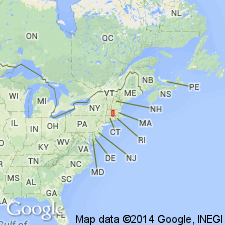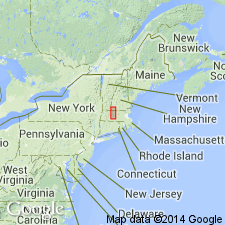- Usage in publication:
-
- Pauchaug Gneiss
- Modifications:
-
- Original reference
- Dominant lithology:
-
- Gneiss
- AAPG geologic province:
-
- New England province
Robinson, Peter, 1967, Progress report on bedrock geologic mapping in west-central Massachusetts: University of Massachusetts, Conference on Economic Geology in Massachusetts Proceedings, p. 29-47.
Summary:
Pg. 30. Pauchaug Gneiss. Consists of massive feldspar-quartz gneiss of intrusive derivation with minor inclusions of amphibolite and layered gneiss. Identical with much of Oliverian Plutonic Series of Billings (1956, Geology of New Hampshire, pt. 2, Bedrock geology: Concord, New Hampshire State Plann. Devel. Comm.) in western New Hampshire. Similar to Swanzey Gneiss (new). Age is Paleozoic.
[Present] in Warwick dome, Orange area, west-central Massachusetts.
Source: US geologic names lexicon (USGS Bull. 1350, p. 559).

- Usage in publication:
-
- Pauchaug Gneiss*
- Modifications:
-
- Overview
- AAPG geologic province:
-
- New England province
Summary:
Used as Pauchaug Gneiss. Age is Ordovician. [No explanation of age change given.]
Source: GNU records (USGS DDS-6; Reston GNULEX).

- Usage in publication:
-
- Pauchaug Gneiss*
- Modifications:
-
- Principal reference
- Age modified
- Geochronologic dating
- Dominant lithology:
-
- Granite
- Tonalite
- Gneiss
- AAPG geologic province:
-
- New England Province
Summary:
Name was applied by Robinson (1967) to massive, intrusive-looking granitic rocks of core of Warwick dome, east of village of Northfield, Franklin County, Massachusetts, and in adjacent New Hampshire. Rocks range in composition from biotite granite to biotite tonalite. Name is also used for massive granitic gneiss in core of Vernon dome in Vermont and New Hampshire. Robinson (1967) avoided assigned Pauchaug to Oliverian Plutonic Suite (Billings, 1955) for rocks in Warwick dome because the Oliverian was thought to be Devonian. The name Monson Gneiss as used by Hadley (1949) is inappropriate because the rocks are not similar. On basis of zircon dating by Zartman and Leo (1985), age of Pauchaug is Ordovician.
Type locality: in upper reaches of Pauchaug Brook in southern parts of Winchester, Cheshire Co., southern NH.
Source: GNU records (USGS DDS-6; Reston GNULEX).

- Usage in publication:
-
- Pauchaug Gneiss
- Modifications:
-
- Geochronologic dating
- AAPG geologic province:
-
- New England province
Summary:
Swanzey, Pauchaug, Monson, and Fourmile Gneisses represent metamorphosed intrusive igneous rocks and yield ages from 454 to 442 +3 / -2 Ma. Therefore, ages range from early Late through latest Ordovician. Authors suggest that they represent the plutonic root of a calc-alkaline magmatic arc at least 250 km long that was produced partly or entirely on a continental margin in the Late Ordovician. The overlying Ammonoosuc Volcanics and Partridge Formation, rather that resting unconformably on these plagioclase-rich plutonic gneiss, are now known to have had a magmatic history overlapping with them and are approximately the same age.
Source: GNU records (USGS DDS-6; Reston GNULEX).
For more information, please contact Nancy Stamm, Geologic Names Committee Secretary.
Asterisk (*) indicates published by U.S. Geological Survey authors.
"No current usage" (†) implies that a name has been abandoned or has fallen into disuse. Former usage and, if known, replacement name given in parentheses ( ).
Slash (/) indicates name conflicts with nomenclatural guidelines (CSN, 1933; ACSN, 1961, 1970; NACSN, 1983, 2005, 2021). May be explained within brackets ([ ]).

